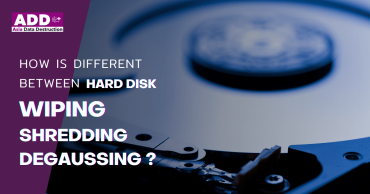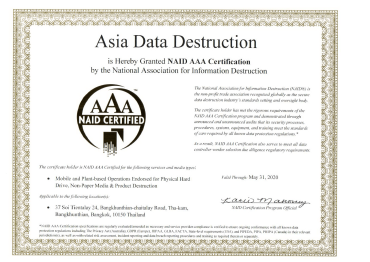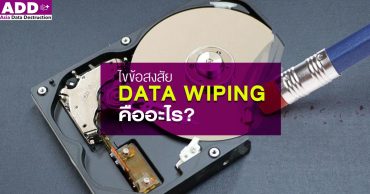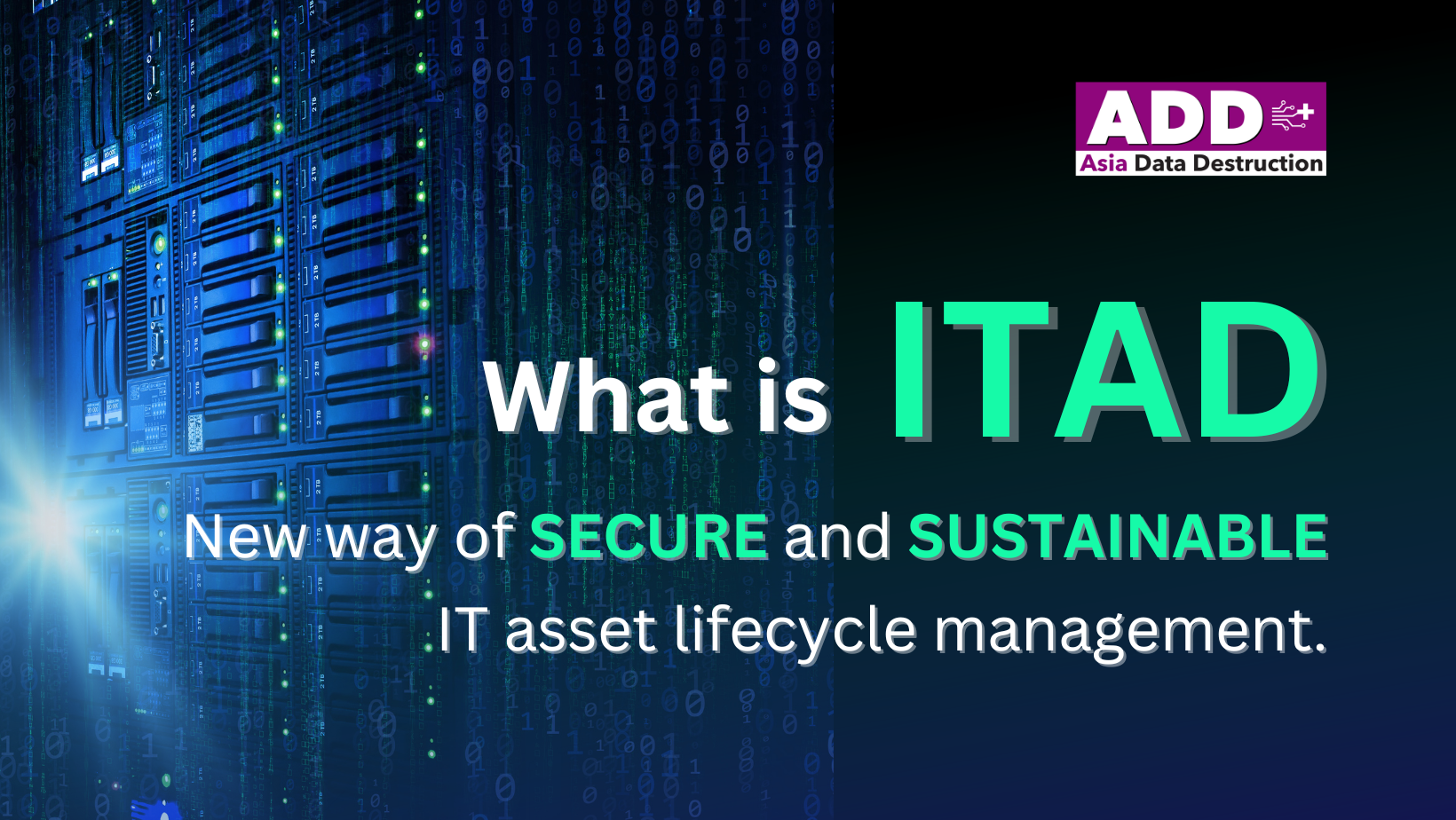
ITAD (Information Technology Asset Disposition) is a process or activity related to managing information technology assets after they are no longer in use or want to be sold from an organization or company. ITAD management is important because it has both Information security and environment Here is an article that explains ITAD in detail.
Table of Contents
What is ITAD?
ITAD is an abbreviation for “Information Technology Asset Disposition,” which is the process or activity involved in disposing of information technology assets (IT assets) after they are no longer in use or need to be disposed of. or company Technology assets include computer equipment, servers, mobile phones, laptops, notebooks, printers, network equipment, and software equipment such as Operating system and software applications
ITAD management is important because technology devices that are no longer in use or are aging may contain sensitive data that must be removed or secured. We often see ITAD activities include data destruction and recycling of technological equipment to reduce their post-use condition and environmental impact. ITAD also involves reselling or donating. (donation) IT equipment that is still in good use to reduce costs or support the public as well.
Importance of ITAD
ITAD management is an important process that helps organizations manage their technology assets effectively. and reduce both safety and legal risks. Here’s why ITAD is important:
information security

Data Security is the protection of important information and important information of an organization or individual from being leaked or accessed by unauthorized persons. Data security is of paramount importance in an era where digital data plays a key role in business activities and success in many industrial fields such as finance, healthcare, retail, internet services, and others.
Information security has many facets. A variety of technologies and regulations are used to protect personal information and confidentiality, including:
- Preventing unauthorized access (Access Control) : Granting access to information only to authorized persons. It uses a system of passwords, authentication, and access rights. (permissions) correctly
- Data Encryption : The use of data encryption technology to maintain the confidentiality of data that is transmitted or stored. Data encryption causes the probed data to be rendered unreadable. It is then decoded to read the data when needed.
- Monitoring and Auditing : Checking access and use of data. To check compliance with security policies and conduct regular audits. To check compliance with policies and regulations
- Security and Incident Response : Implementing measures to prevent unauthorized access and responding to data security breaches. This includes notifications and recovery after hacking.
- Network Security : Preventing unauthorized access and evacuating viruses and threats from an organization’s network. by using firewalls (Intrusion Detection and Prevention Systems) and network-related security arrangements (Network Security Protocols)
- Device Security : Protecting data on devices with installed software and applications, password protection, mobile device management, and control of lost or stolen devices.
- Database Security : Preventing unauthorized access to important databases. Using database encryption, database encryption, row-level access control, and database permission control.
- Physical Security : Data security by controlling access to connection rooms and servers. Use of biometric access control systems and automatic door opening and closing systems (Access Control Systems)
- Security in software development (Application Security) : Securing data by designing and developing software that is safe from programmatic attacks. Application-level attacks, such as cluster drain (Cross-Site Scripting) and unauthorized service calls (Unauthorized Service Invocation) including regular code testing and review.
- Cloud Security : Protection of data stored in the cloud. Using data encryption, access control, and data security management in the cloud
- Security Governance : Maintaining information security with security controls, clear security policies, training employees to understand and follow policies, and having a structure for security responsibility. information
- Raising awareness (Security Awareness) : Training employees and users on information security, so they can recognize risks, be careful before falling victim to a security breach, and follow security policies.
Information security is a process that must be followed regularly. This is because technology and security intrusions are constantly changing. And ensuring data security is essential to protecting against legal risks and risks to an organization’s business model. The organization is responsible for protecting the data of its customers and users and must ensure the security and privacy of their data in all situations.
environment

Data security and safety for the environment (Environmental Security) is security related to the protection and security of the external environment that affects the organization. Environmental sense regulation has many facets and includes managing the environment, preventing environmental problems, and dealing with situations that affect the organization’s environment. Here are some important points about safety for the environment:
- Environmental management (Environmental Management) : Environmental management is the process that an organization uses to maintain safety and environmental responsibility. This includes ensuring that the environmental impact of the organization’s activities is monitored and assessed. Including the use of technology and methods to reduce environmental impacts.
- Prevention of environmental problems (Environmental Hazard Prevention) : Inspecting and preventing environmental problems that may occur, such as securing environmentally-related facilities, preventing toxic spills, and dealing with environmentally hazardous drugs.
- Dealing with situations that affect the environment (Environmental Incident Response) : Determining plans to be used when situations that have an impact on the environment occur, such as dealing with toxic spills, and striving to quickly and efficiently reach and deal with environmental risks.
- Environmental risk assessment (Environmental Risk Assessment) : Conducting an environmental risk assessment to identify and analyze risks that may occur to the organization’s environment. It includes risk assessment from environmental activities, environmental impact assessment, and risk management plans.
- Site Security : Security of the premises where the organization is located or conducts activities. To prevent risks to the environment and the safety of people living in that area.
- Dealing with natural disasters (Natural Disaster Response) : Dealing with natural disasters that may occur and have an impact on the environment, such as floods, earth flows, and threats from nuclear accidents.
- Environmental Risk Prevention (Environmental Risk Mitigation):
- Reducing environmental risk by making decisions and implementing plans that reduce risk. By taking appropriate environmental measures, such as using appropriate technology, managing the environment with appropriate negligence determination systems, and developing plans to manage environmental risks.
- Customer safety and environmental responsibility (Customer and Environmental Responsibility) : Maintaining the safety of customers and users of the organization’s products or services. By managing products or services to have the least impact on the environment. and provide information about environmental impacts to customers
- Environmental impact assessment (Environmental Impact Assessment) : Assessment of the environmental impact of a project or activity in the planning stage. To adjust plans and operations to have the least impact on the environment.
- Compliance with laws and regulations (Compliance) : Compliance with laws and regulations related to environmental safety, reporting environmental impacts according to law, and assessing risks to laws and regulations.
Safety for the environment is an important part of the responsibility for organizations that want to maintain environmental safety and assess the impact of their activities on the environment. Controlling your sense of environment helps prevent environmental risks, reduces environmental impacts, and helps build a good corporate image in society and in the market.
Save resources

Resource Conservation is a process used by organizations or individuals to reduce their use of natural resources and reduce their impact on the environment. Including reducing costs in terms of resources and energy. Saving resources is important in countries around the world because the use of resources and energy has an impact on environmental change and planetary deterioration. Here are some steps and methods that can help in saving resources:
- Energy Management : Reducing energy use as much as possible by using energy management technology, using energy saving technology, investing in clean energy, and controlling unnecessary energy use.
- Reducing water use (Water Conservation) : Reducing water use in production processes and daily activities. Using water saving technology, stopping water leaks, and controlling water use in the organization.
- Material Reduction : Reducing the use of unnecessary materials in the production process. Reducing the use of packaging and stopping material wastage
- Recycling and Resource Recovery : Bringing equipment or materials that are no longer in use into the recycling process or collecting them in other ways, such as recycling materials and recycling them for reuse. new
- Clean Energy Use : Using energy from energy sources that have the least impact on the environment, such as solar energy, wind energy, and energy from fuel cells.
- Greenhouse Gas Emission Reduction : Reducing greenhouse gas emissions that affect environmental changes. Using technology that reduces greenhouse gas emissions, uses clean energy, and controls production processes that have low greenhouse gas emissions.
- Waste Reduction : Reducing losses caused by production and consumption processes. By using the recycling process, reducing the use of unnecessary materials, and controlling the wastage situation.
- Use of modern technology (Advanced Technologies) : Using modern technology to reduce the use of resources and energy. This can include using the Internet of Information to control processes and increase efficiency in resource management.
- Suspension of environmental risks (Environmental Risk Mitigation) : Controlling and reducing potential environmental risks by using appropriate environmental measures and environmental risk management planning.
- Education and Training : Providing knowledge and training to employees and users on how to conserve resources and deal with the environment appropriately.
- Monitoring and Reporting : Monitoring resource use and environmental impacts of the organization, reporting resource saving results and success in reducing resource use.
Saving resources is beneficial not only to the environment and the organization’s image. But it can also reduce costs, increase efficiency, and enhance the organization’s positive image in the market and in the society it is part of. Saving resources is an important part of corporate sustainability and success in an era where environmental responsibility is becoming more important every day.
Improving awareness and best practices
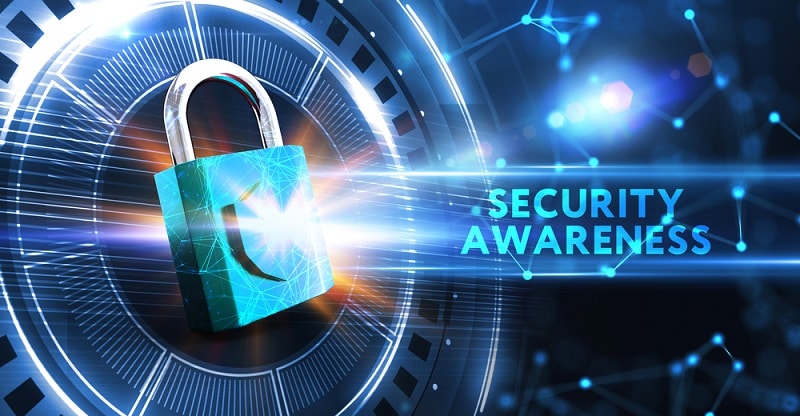
Improving Awareness and Best Practices is an important step in creating responsibility for safety, resource conservation, and environmental protection in an organization. Improving awareness and best practices emphasizes building understanding, training, and promoting good behavior regarding safety, resource use, and environmental protection. Here are some steps and methods that can be used to improve awareness and good practice:
- Creating Awareness : Starting with creating an understanding of safety, saving resources, and preserving the environment in the organization. using communications, distributed materials, training, and publications
- Training : Providing knowledge and skills to employees and users regarding safety, resource conservation, and environmental protection. Through technical training and awareness raising
- Setting standards and requirements (Establishing Standards and Requirements) : Setting standards and requirements related to safety, resource saving, and environmental protection. that will be used as a guideline for work
- Promotion and Advocacy : Supporting responsibility for safety, resource conservation, and environmental protection. by using promotions and activities that support this responsibility This may include creating rewards and compensation.
- Planning and Implementation : Clear implementation planning to ensure responsibility for safety, resource conservation, and environmental protection is an essential part of successful operations.
- Monitoring and Evaluation : Checking whether responsibilities and awareness are being met. and performance evaluation to improve and adjust future operations.
- Sharing knowledge and success (Knowledge Sharing and Best Practices) : Sharing knowledge and being successful in taking responsibility for safety, saving resources, and preserving the environment in the organization, to strengthen responsibility in people. other
- Reporting : Reporting results regarding safety, resource saving, and environmental protection to relevant parties, such as customers, employees, companies, and organizations that may have an impact or Participate in this matter
- Goal Setting and Measurement : Setting realistic and measurable goals so that progress can be tracked in fulfilling responsibilities in safety, resource conservation, and environmental protection.
- Dealing with Challenges and Adaptation : Dealing with difficulties and adapting to conditions or situations that may change. Planning and improving operations to suit new situations or changes that occur.
Improving awareness and best practices is an ongoing process that helps organizations operate sustainably, conserve resources, and protect the environment more effectively. It also builds a positive image for the organization and helps it set an example of environmental responsibility within its ranks and in the communities with which it engages.
ITAD steps and processes
The ITAD procedure and process consists of several key steps:
Assessment (Assessment)

Assessment is a process used to analyze, evaluate, or measure things to understand their integrity, quality, performance, or risk in a variety of situations. Assessment can be used in many areas of life, such as in evaluating safety in organizations, evaluating learning outcomes in education, evaluating the environmental impact of projects, or evaluating the health of individuals.
Assessment can be done using a variety of methods and tools, which may be qualitative or quantitative in nature. Here is an example of a multi-faceted assessment:
- Environmental safety assessment (Environmental Safety Assessment) : Assessment of the environmental impact of an activity or project. Using scientific tools to measure chemical releases or environmental impacts, such as analyzing the quality of water in streams or analyzing the amount of greenhouse gases.
- Learning Assessment : Measuring a learner’s knowledge, skills, and understanding in a variety of situations, such as using exams, practical tasks, or student opinion surveys.
- Performance Assessment : Measuring the efficiency and quality of work of individuals or organizations. By using quantitative or qualitative indicators such as evaluating the performance of employees in the organization or evaluating the quality of products.
- Risk Assessment : Assessment of risks to safety, health, environment, or others using scientific data and statistics. To adjust risk management plans or reduce risks.
- Health Assessment : Assessment of the health of an individual or group of people. Using a physical examination, symptom survey, or measurement of toxins in the body.
Assessment is an important step in safety management, educational development, quality control, risk control, and effective operations in many situations and organizations. Using appropriate methods and tools for assessment is It is important to obtain accurate and effective information and assessment information.
Disposition
Disposition is a process or operation involving the management of data or resources so that they are permanently or permanently removed, destroyed, or otherwise determined from an organization or system as part of the data management lifecycle. The disposal process often involves removing unnecessary data from a system or organizational context to save space, reduce security risks, or provide routine information to the organization.
Examples in the distribution process:
- Destruction : The permanent destruction of information or resources that will be sold. This could be destroying unnecessary documents, destroying digital data, or destroying unused equipment.
- Deletion : Removing unnecessary data or digital information from a system or server. using a secure deletion method
- Asset Disposition : The sale or management of equipment that is not in permanent use. This could be for sale, donation, or reuse. or destruction according to the chapter according to the organization
- Data Disposition : Managing unnecessary data in an organization. By deleting or destroying unnecessary data. To save space on the storage device
- Computer resource distribution (IT Asset Disposition – ITAD) : Management of computer equipment or information technology equipment that is not in use. It may be the sale or destruction of these equipment.
- Disposition of responsibility Responsibility Disposition : Decisions regarding the distribution of responsibilities in an organization, such as creating a new management structure or transferring rights to others.
Sales can be an important part of controlling information security, managing equipment, and creating organizational agility. Sales operations must comply with relevant laws and regulations, and must be carried out carefully to prevent information leakage or risks associated with sales.
Deleting data (Data Destruction)

Data Destruction is a process used to destroy unnecessary data and make it unrecoverable. Data deletion can be done in a number of ways. And choosing the right method depends on the nature of the data and the desired level of security.
Here are the methods that can be used to delete data:
- Software Erasure : Using software to erase data from devices or storage devices. This method does not permanently destroy the data. But it causes the data to be overwritten with random data that cannot be read again.
- Physical destruction (Physical Destruction) : Destroying equipment or data storage media so that they cannot be used again. This may involve destroying hard drives, CDs, DVDs, magnetic tapes, or other devices using special tools such as rollers, steel cable reels, or grinders.
- Data Wiping and Sanitization : Using software to erase and wipe data from a device or data controller. In this process, data is repeatedly overwritten with random data so that it cannot be recovered again.
- Degaussing : Using a tool called a “degausser” to erase information on magnetic media by creating a magnetic field that causes the information to be erased.
- Paper and document destruction (Paper Shredding) : Using a paper shredding machine to destroy documents containing important information. By making the paper into smaller pieces that cannot be combined again.
- Multimedia Destruction : Destroying unnecessary media devices such as CDs, DVDs, USBs, and other storage devices using appropriate tools.
The selection of data deletion methods should be based on an assessment of data security and confidentiality. This ensures that the deletion is permanent and cannot be recovered again. It is important to perform data deletion operations in accordance with laws and regulations related to data security.
Recycling

Recycling is the process of collecting, converting, and reusing old and unusable materials or items. This is to reduce the use of new materials and reduce the amount of waste that will be discarded at landfill sites. Recycling plays an important role in reducing environmental impact, reducing resource use, and reducing waste in society.
Here are the main steps in the recycling process:
- Collection : Starting by collecting materials or items at a waste center or collection project. Collected materials may include paper, metal, plastic, and glass.
- Conversion : After collection, materials are taken to conversion plants that use special machinery and processes to convert these materials into new materials. Conversion may include melting and shaping fibers to create new products.
- Reuse : New materials or products obtained from the conversion process are reused in the production process. For example, reusing recycled plastic bottles to produce new plastic bottles.
- Reducing resource use : Recycling reduces the use of natural resources. This is due to the reuse of existing materials. Therefore, there is no need to drill or produce new materials for use in production.
- Reducing Waste : Recycling reduces the amount of waste that ends up in landfills. This helps reduce waste generation and environmental efficiency.
- Environmental Support : Recycling promotes environmental responsibility and careful use of materials. That can help reduce the use of natural resources and increase environmental efficiency.
Donation

Donation or donation of IT equipment that is still in good working order to organizations in need, such as schools or charities. To support knowledge and technology in the community It is a process in which people or organizations have things or resources and want to give them to other organizations or people. Without expecting compensation of 100,000 baht or financial items in exchange. Donating is characterized by an act of solidarity and excellence in society. To help others or support good things
Here are some types of donations.
- Donation : Giving money to a non-profit organization or social cause, such as donating money to a school, foundation, or charity.
- Donation : Giving materials, food, clothing, books, or other items to people in need or organizations in need, such as donating free food to the poor, donating unused clothing to disaster victims. , or donating items for the school.
- Donating time : Giving time and cooperation to join a social project or organization. This can include formal volunteering or participating in charitable activities.
- Donating to others : Giving knowledge, ideas, skills, or resources to others, such as teaching, evaluating, or advising.
- Donating blood or craft equipment : Giving blood or craft equipment to help patients or procuring craft to send to hospitals.
Donations are an important part of community and society. It provides support to those who need it and can be a vital force in building healthy, collaborative social relationships.
Resale of Remaining Assets
Resale of Remaining Assets is the process by which organizations or individuals have technological assets that are no longer in effective use or that are about to be sold. If there is IT equipment that is still valuable and can be sold, Organizations can sell this equipment to make a profit. Sell or manage this property for the benefit of the organization or individual. Managing the remaining technology assets is often a matter of careful planning and there are many methods that can be used in this process. Here are some examples:
- Selling old equipment : If the organization has remaining technological equipment that is still usable. They may decide to sell them to other individuals or organizations in need. This can help them generate additional revenue or reduce the costs of maintaining old equipment.
- Donations : Organizations or individuals can choose to donate unused technological equipment to charities or social causes. This increases the social value of the property and helps support good causes in the community.
- Reuse : The remaining technological assets may be reused in the organization. By upgrading or improving equipment
- Destruction or disposal of non-recyclable assets : Some remaining technological assets may not be worth reusing or selling. In this case, destruction or disposal of property that is no longer in use may be an option.
Managing remaining technological assets involves donating, selling, donating or destroying equipment that is no longer in use. This depends on the nature of the property and the objectives of the organization or person involved.
Reporting and Documentation
Reporting and Documentation is an important process in managing data and information in an organization. Recording information related to ITAD management, including reporting of data destruction and filing of IT asset management procedures. Reporting is the presentation of important data or information through reports or documents. So that those interested can understand and use that information in decision making or management. Data retention involves keeping documents or data safe and long-term in accordance with relevant regulations and laws.
Here’s how important it is to report and retain information:
- Decision making : Reporting helps in making business and management decisions. By providing accurate and timely information to executives and decision makers so that they can make informed and informed decisions.
- Information rights : Preserving documents and information in an organized or organized manner may be of legal importance. For use in confirming business operations, handling legal cases, or as future evidence.
- Risk Control : Reporting and data retention help in controlling business risk. It provides information that forms the basis for developing and implementing legal activities, information security, or managing business issues.
- Sharing information : Reporting helps in sharing information in the organization. Make everyone understand the current status and goals of the organization. It also helps create effective communication.
- Elections and Follow-Up : Reporting helps with targeted elections, follow-up, and operational analysis. To be able to carefully improve the operational plan.
- Being learning information : Keeping information in the organization helps to be learning information. Past data can be used to improve future actions.
Reporting and maintaining data is an essential part of managing an organization efficiently and objectively.
ITAD Good Practice Guidelines
Good ITAD practices include following laws and regulations related to information security and the environment. Creating an Effective ITAD Asset Management Plan Using appropriate data destruction methods and using the correct recycling and donation methods
This also takes into account environmental responsibility and ensuring customers and partners that data is handled securely and discarded. Create a good image of the organization and help reduce legal risks
ITAD management is an essential process for organizations looking to improve the efficient and secure management of their technology assets. It also reduces environmental impact and creates responsibility for doing the right thing for society and the environment.
Summary of content
ITAD or Information Technology Asset Disposition is the process of efficiently managing technological assets and information that are not in use. This process involves organizations or individuals wanting to manage old technology devices, no longer in use, or leftover technology assets in a secure and sustainable way. ITAD processes include erasing data on devices, donating them. , selling, extorting property, or destroying technological property that is no longer in use. and documents and data are preserved for security and legal compliance. ITAD processes play an important role in reducing information security risks, saving resources, improving awareness and best practices, recycling and management. Remaining technological assets to be effective And it plays a role in building social relationships and helping organizations that need leftover technological assets go to organizations or individuals in need. ITAD is important in the efficient and secure management of technological assets in the field of technology. Information and computers
If anyone wishes to destroy data or wants to destroy IT assets that are no longer in use, we, Asia Data Destruction, accept data destruction and IT assets destruction for the safety of the property and organization. There are all types of destruction methods available for destroying sensitive data. Don’t let your sensitive data fall into the hands of commercial threats or those with bad intentions.
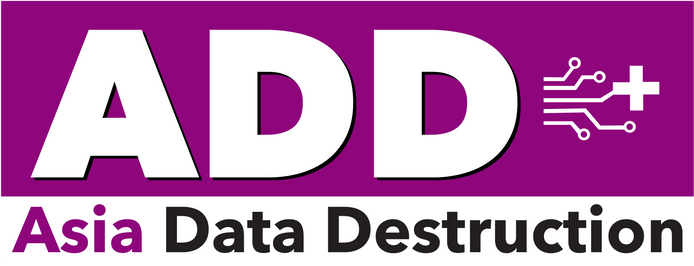

 ไทย
ไทย 日本語
日本語 Tiếng Việt
Tiếng Việt ភាសាខ្មែរ
ភាសាខ្មែរ